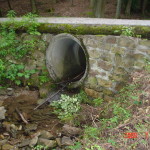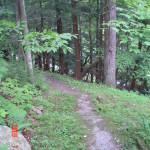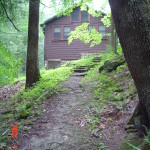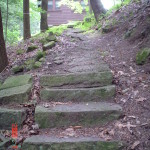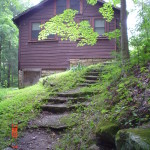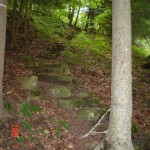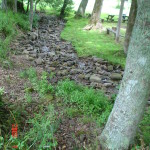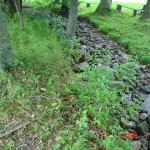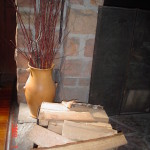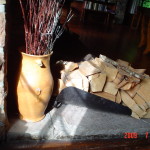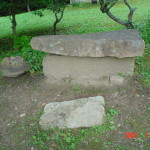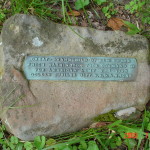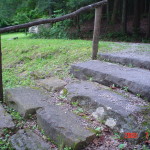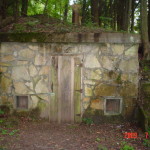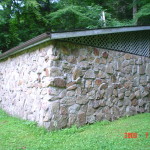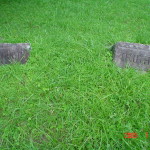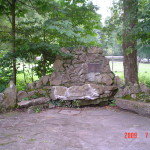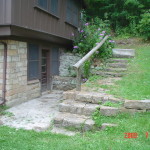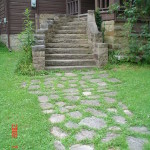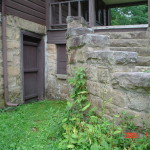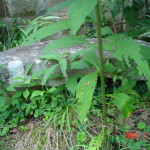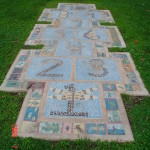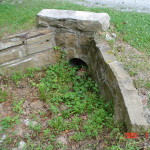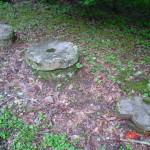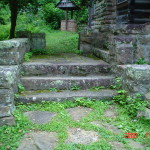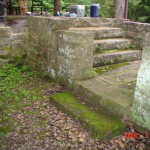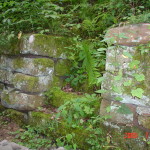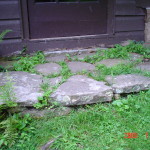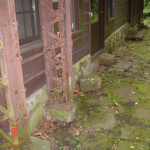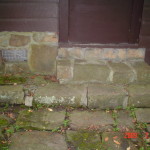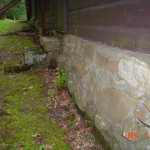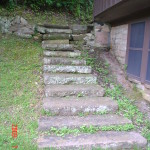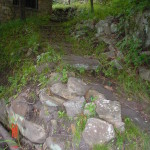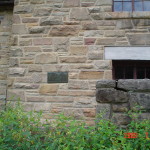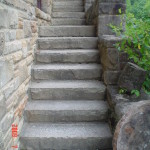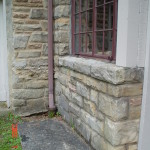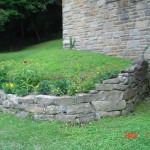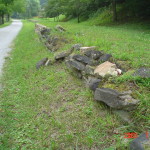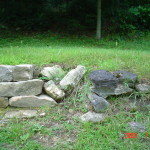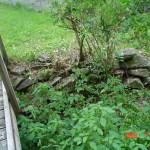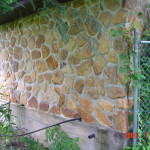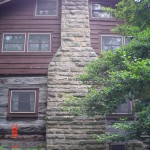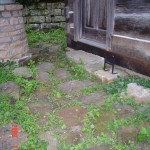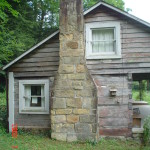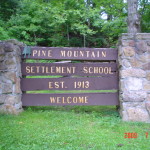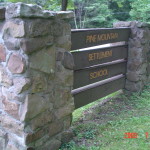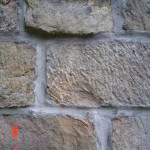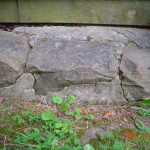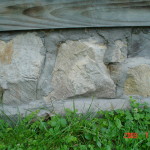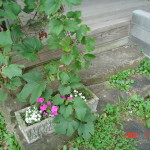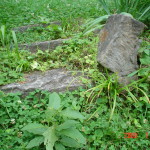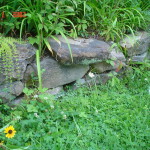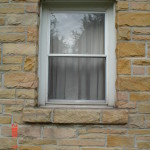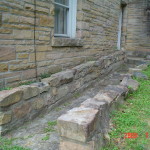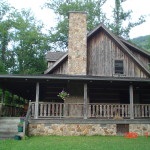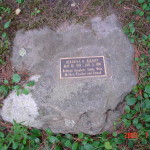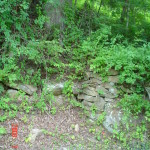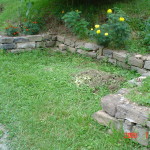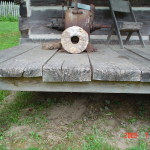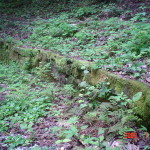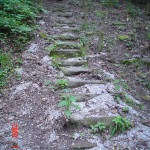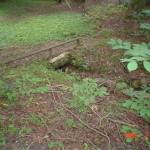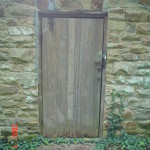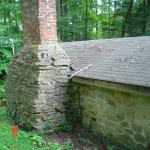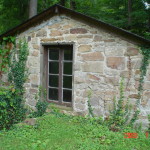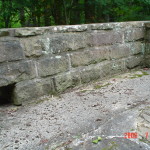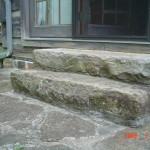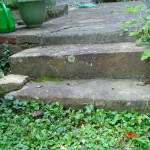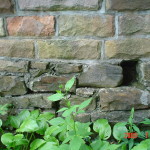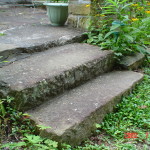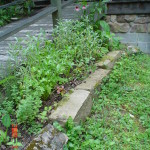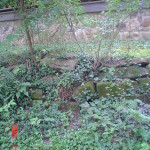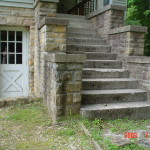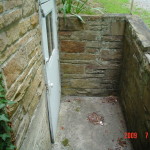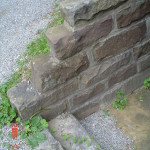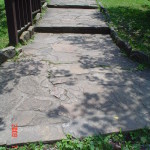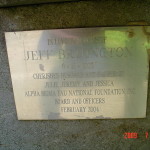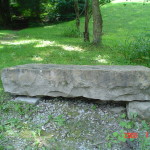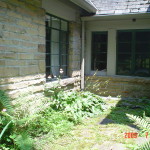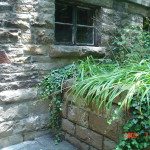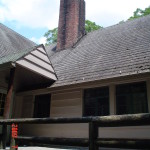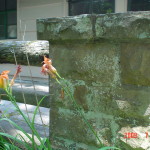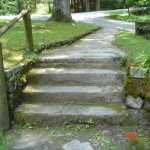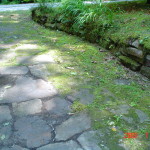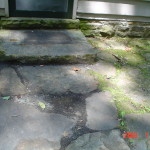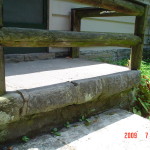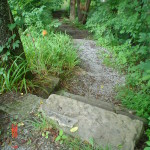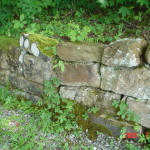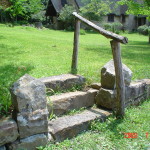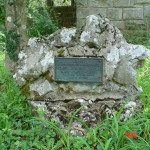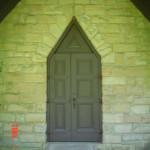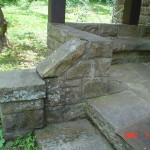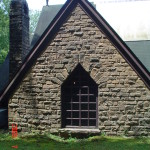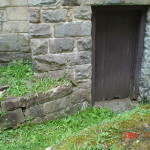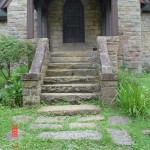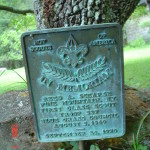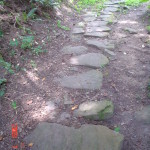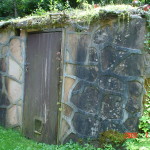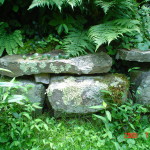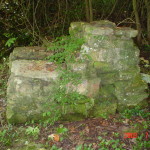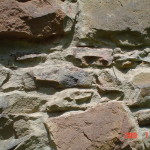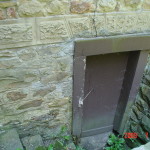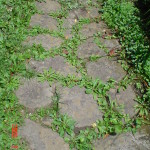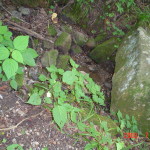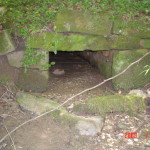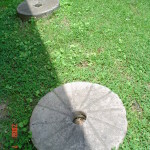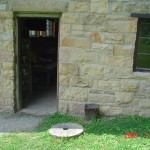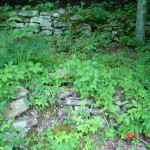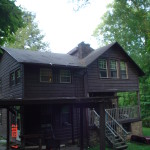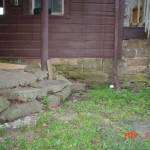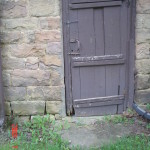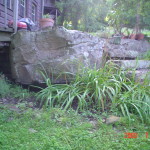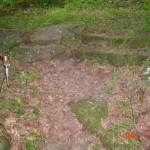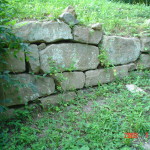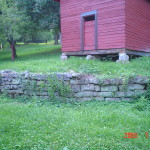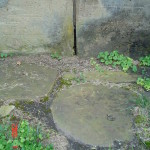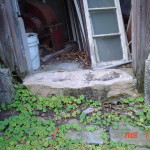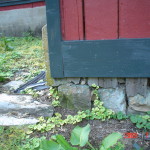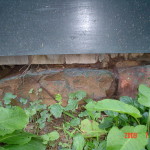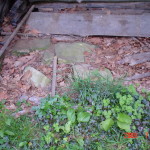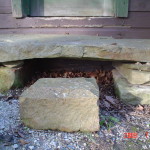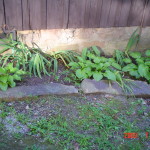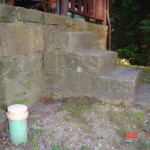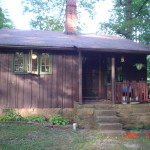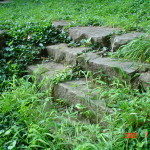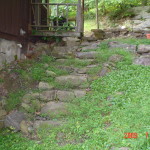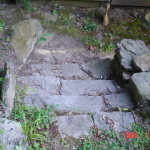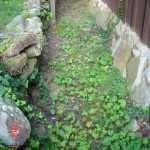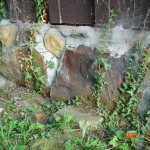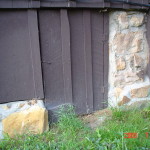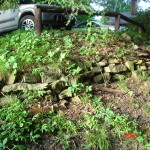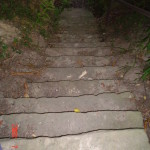Pine Mountain Settlement School
Series 10: BUILT ENVIRONMENT
Rockwork
Stonework
Masonry
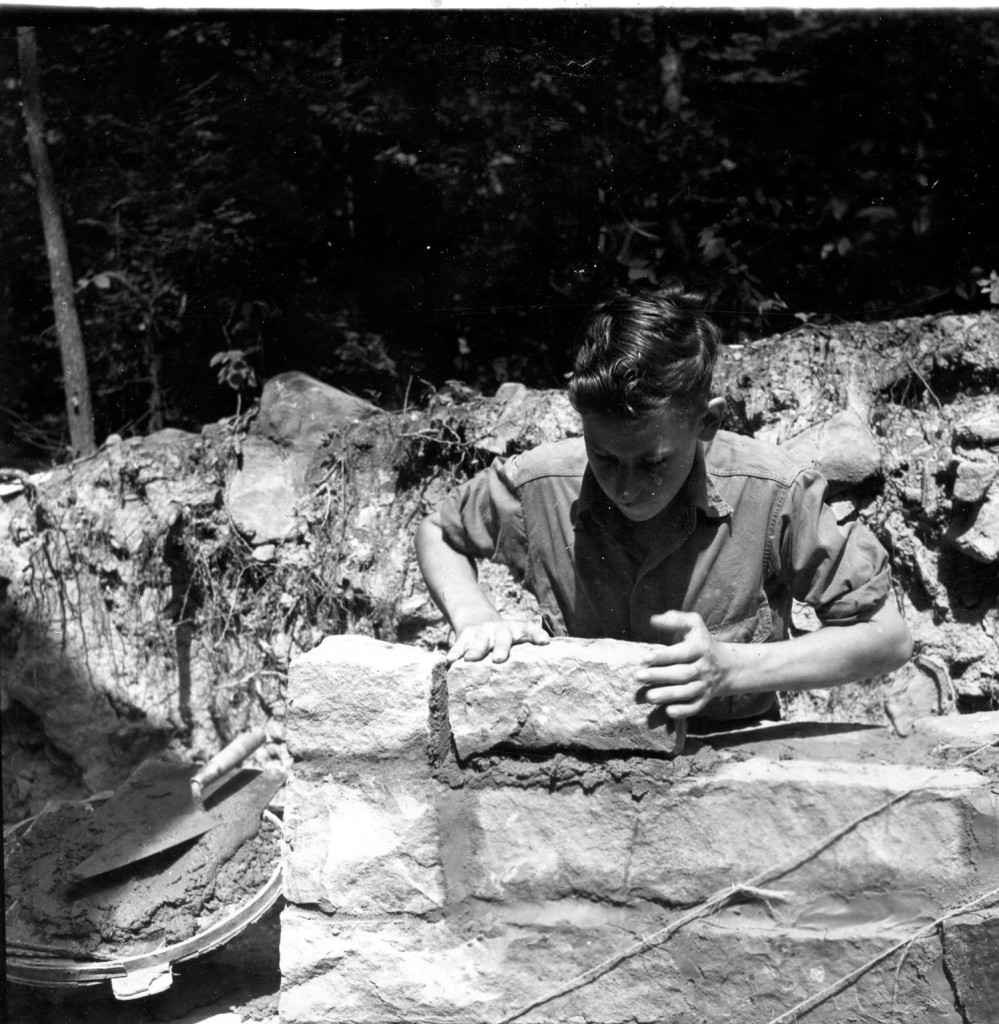
Student assisting with stone work on Laurel House II walls. Harmon Foundation still, 1941. [pm_harm_060.jpg]
TAGS: Rockwork, stonework, stone masonry, Andy Dorsky, stone masons, Luigi Zande, European stone masons, master builders, craftsmanship, industrial training, stone masons, limestone, sandstone, quarries, stone quarry
ROCKWORK, STONEWORK, and MASONRY
Pine Mountain is known for the remarkable stonework in its buildings and in the landscaping. Several names in the written record o. f the institution suggest workers who were proficient at the trade. One of those is Andy Dorsky [Andy Drozky ?], an Austrian who came to the Pine Mountain valley from one of the county coal camps or possibly from Whitesburg which had many Italian and European mason employed to build structures for the mining community. He followed the consummate rock-work of the mason, Luigi Zande who married Ethel de Long, a founder of the Pine Mountain Settlement School in Harlan County, KY.
ROCKWORK, STONEWORK, and MASONRY: Andy Dorsky
It was Andy Dorsky who carved the civics lesson into the stones used in the foundation of the Mary Sinclair Burkham School House II and that today are in the field where the Schoolhouse stood before its destruction by fire in 1983. Dorsky also played an important role in the rockwork of the new Laurel House II and his work may be seen in the large fireplace and chimney in the building. Dorsky was also helpful to many in the Community. The story told by the Creech family is that he was responsible for the steps leading up to the new front porch of the Henry Creech home on Isaac’s Creek … completed following his fall from a temporary plank used to reach the porch.
ROCKWORK, STONEWORK, and MASONRY: Luigi Zande
Luigi Zande, a master stone mason from norther Italy, came to Pine Mountain following work in the nearby coal camps. His work may be seen in Zande House which he built for Ethel de Long Zande following their marriage. The Chapel stonework is also largely credited to Zande and his direction. The corbel arch masonry that is seen throughout the Chapel is dramatically altered in the Roman Arch that frames the altar — the work and the design of Luigi Zande.
Interview with James Charles Creech
James Charles Creech elaborates on the stonework at Pine Mountain in his oral interview in October of 1997 …
Well, we’ll go back to the early days of getting Pine Mountain Settlement School started, and to my grandfather, who was very instrumental in getting this school started. As a matter
of fact, he gave the land and begged fotched-on women [Katherine Pettit and Ethel de Long] to getting the school going. Anyhow, when they started building, they needed builders, because the local people they could get really knew nothing about modern building and, then even so, it was not very modern building at that time, in the late teens and early twenties.
Valli: Did they have public building codes then?
A: No public codes. They hadn’t heard of public building codes then anywhere. But anyway, the women that were getting this thing going saw the need of people who knew building. And at that time they were building railroads into that area, not in the immediate area, but into southeastern Kentucky, and they were opening coal mines; and they were building coal camps. So, they went to the head, I think it was U.S. Coal and Coke, somebody like that, and told them what their problem was. And they gave them a couple or three builders who knew building, stone masons in particular. And they brought them into the valley where Pine Mountain School stands now. One of these importees, Andy Drozky, that was boarding with my parents, and Dad got a front porch added onto the house with no steps leading up to it. They put, I think, a 2 X 8 timber to walk up onto the porch! Good old Andy got a little too much wine somewhere or other, and he fell off the thing when he got almost up to the porch. Didn’t hurt him too much, but it hurt his pride that he couldn’t walk up to that porch level. And he says, “Henry, we’re going to change that.” So that was all he ever said about it like that; and he looked around over the land there, and he found a rather large boulder that he thought would do what he wanted to, and he proceeded to chisel out steps to go up to the house. These steps really were beautiful work. The top of it just as smooth as it could be, and not only did he round off the edge, he sort of tucked on under it so there was very definitely a half of a cylinder of stone all the way across here. So they proceeded to find a gallon or two of wine and put those in.
Valli: How did they get them moved up to the house?
A: Hitched a horse or a mule to a sled and shove[d] them on there; then haul[ed] it up there.
Valli: When they brought them up how did they attach to the porch, or…?
A: Yes, what they did was to take a row of rock here cemented together and put the
bottom step on this rock; then this next one here, they built it up higher and put the next one on, and so on till they got three steps up there, or four, whatever it was. But anyway, Jim [Ruth and Charles’s son?] and Ruth [Smith Creech [have] a very sad memory of those steps because they picked up a gallon jug or half gallon jug or something like that of honey. And Jim was carrying it, tripped on the steps and his jug of honey spread all over the steps, and he squeaked (?) them but good. Correct? That happened, didn’t it?
ROCKWORK: GALLERY I
- rockwork_061_laurelhouse_culvert
- Hill House steps and pathway. rockwork_018_hillhouse_path.jpg
- Hill House steps and pathway. rockwork_019_hillhouse_path_steps.jpg
- Hill House steps and pathway. rockwork_020_hillhouse_path_steps
- Hill House steps and pathway. rockwork_021_hillhouse_path_steps
- Hill House steps and pathway. rockwork_022_farmhouse_path
- rockwork_023_laurelhouse_creek
- ockwork_024_laurelhouse_creek
- Laurel House II fireplace. rockwork_025_laurelhouse_interior_fireplace
- Laurel House II fireplace. rockwork_026_laurelhouse_interior_fireplace
- Rock bench in front of Laurel House II. rockwork_027_laurelhouse_bench_flagstone
- Laurel House II, bench to left of main entry. rockwork_028_laurelhouse_bench
- rockwork_029_laurelhouse_plaque
- Hill House steps leading from roadway to building. rockwork_030_picnicgrounds_steps
- Root Cellar, 2009. [rockwork_031_picnicgrounds_root cellar]
- Restrooms near ball field. rockwork_032_picnicgrounds_bathroom.jpg
- Andy Dorsky carved stones from Burkham II following fire. rockwork_033_playground_plaques_honesty_self-control
- Andy Dorsky carved stones from Burkham II following fire. rockwork_033_playground_plaques_honesty_self-control
- William Creech Fountain, 2009. [rockwork_035_girlsindust_creech_memorial_plaque.jpg]
- Girl’s Industrial (Plant Center, Industrial Kitchen) rockwork_036_girlsindust_steps_walls
- Boys House (Library) steps rockwork_037_boyshouse_walk_steps
- Boys House (Library) steps rockwork_038_boyshouse_foundation_walls
- Boys House (Library) back flank stepping stones. rockwork_038_boyshouse_foundation_walls
- Art project on Playground. rockwork_040_playground_hopscotch
- rockwork_041_biglog_culvert
- Millstone rockwork_042_biglog_millstone
- rockwork_043_biglog_steps_walk_ well
- rockwork_044_biglog_step_ walls
- rockwork_045_biglog_retaining_wall
- Rockwork and steps behind Boys House (Library) rockwork_046_boyshouse_doorstep
- Rockwork and steps behind Boys House (Library) rockwork_047_boyshouse_rear_doorsteps_flagstone
- Rockwork and steps behind Boys House (Library) rockwork_048_draper_doorstep_foundation
- Rockwork and steps behind Boys House (Library) rockwork_049_draper_rear_doorstep_foundation
- rockwork_050_girlsindust_steps_walls
- rockwork_051_draper_steps
- Draper Building facade rockwork. rockwork_052_draper_walls_plaque
- Draper main stairwell. srockwork_053_draper_steps_walls
- rockwork_054_girls industrial_walls
- rockwork_055_draper_walls_flowerbed
- Rockwall before dry-stack reconstruction on main entry road bordering Isaasc’s Creek. rockwork_057_draper_old_wall
- Rockwall before dry-stack reconstruction on main entry road bordering Isaasc’s Creek. rockwork_058_draper_old_new_wall
- Rock wall before restoration. [rockwork_059_draper_creek.jpg]
- Change house for former Swimmiong pool. [rockwork_060_swimmingpool_change_house]
ROCKWORK: GALLERY II
- [rockwork_062_oldlog_entrance_sign.jpg]
- Old Log chimney. [rockwork_065_oldlog_chimney_detail.jpg]
- Old Log step. [rockwork_066_oldlog_step.jpg]
- Old Log foundation. [rockwork_067_oldlog_foundation.jpg]
ROCKWORK: GALLERY III
- [rockwork_076_creechcabin_foundation.jpg]
- Dancing Green, stone wall, 2009. [rockwork.078_dancinggreen_wall.jpg]
- Dancing Green, stone steps, 2009. [rockwork.078_dancinggreen_steps.jpg]
- Dancing Green, stone culvert, 2009. [rockwork.078_dancinggreen_culvert.jpg]
- Far House patio & retaining wall, 2009. [rockwork_083_farhouse_wall.jpg]
ROCKWORK: GALLERY IV
- Root Cellar. [rockwork_118_zande_rootcellar.jpg]
- Tool Shed II, shop doorway. [rockwork_127_toolshed2_wall]
ROCKWORK: GALLERY V
- Stonework. Jubilee Cottage. [rockwork_144_jubilee_foundation_flowerbed.jpg]
- Rockwork steps at Jubilee Cottage. [rockwork_145_jubilee_steps_foundation.jpg]
- Rockwork steps at Jubilee Cottage. [rockwork_146_jubilee_steps_foundation_floor.jpg]
- Jubilee Cottage. View of facade and steps. [rockwork_147_jubilee_walk_steps_foundation_chimney.jpg]
- Rockwork. Steps at Jubilee Cottage. [rockwork_148_jubilee_steps.jpg]
- Country Cottage (Practice House, Model Home).Stone steps beside East entrance.
- Country Cottage (Practice House, Model Home). Stonework behind the house
- Country Cottage (Practice House, Model Home). Stonework.
- Country Cottage (Practice House, Model Home). Board and batten construction.
SEE ALSO:
DANCING IN THE CABBAGE PATCH Stones, More Stones….
LUIGI ZANDE Staff Biography
WILLIAM CREECH Memorial Fountain
WELLS RECORD PMSS 04 PMSS Physical Growth 1913-1928

